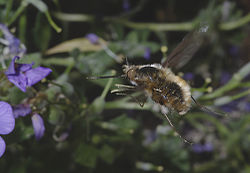- Bombylius major
-
Bombylius major 
Scientific classification Kingdom: Animalia Phylum: Arthropoda Class: Insecta Order: Diptera Family: Bombyliidae Genus: Bombylius Species: B. major Binomial name Bombylius major
Linnaeus, 1758Synonyms - Asilus lanigerus Geoffroy, 1785
- Bombylius aequalis Fabricius, 1781
- Bombylius albipectus Macquart, 1855
- Bombylius anonymus Sulzer, 1761
- Bombylius antenoreus Lioy, 1864
- Bombylius australis Loew, 1855
- Bombylius basilinea Loew, 1855
- Bombylius consanguineus Macquart, 1840
- Bombylius fratellus Wiedemann, 1828
- Bombylius variegatus De Geer, 1776
- Bombylius vicinus Macquart, 1840
The large bee fly, Bombylius major, is a bee mimic. The eggs are flicked by the adult female toward the entrance of the underground nests of solitary bees and wasps. After hatching, the larvae find their way into the nests to feed on the grubs.[1]
Bombylius major can be found in April to June throughout temperate Europe and North America and some parts of Asia.
Contents
Description
Large bee fly in early springtime (video, 2m 10s)
The adult is 14 to 18 millimetres (0.55 to 0.71 in) in length, squat and very hairy, with a wingspan of around 24 mm (0.94 in). It has dark patches on the anterior half of the wings and long hairy legs that dangle while in flight. Bee flies are expert flyers, and their hovering habit has led to their being incorrectly called a species of hoverfly (Syrphidae). The very long proboscis is used to feed on the nectar of many species of flower, especially primroses.
Bombylius major is one of two species that are large bee-flies. The other being the very rare dotted bee-fly (Bombylius discolor).
Bearing an extremely strong resemblance to bees their body is stout and furry, with the top of the thorax being black and shiny and the pile either brown, yellow, or white. They have long spindly legs as well as a long rigid proboscis found in the front of the head. Their boldly patterned wings have a distinct dividing border through the horizontal middle between the dark and clear portions. Their antennae are typically very short and pointed. In the field they will be seen hovering and darting above bare ground or flowers, in an up-and-down movement, accompanied by a high-pitched buzz.
Reproduction
Bombylius major mimic bees to allow them to get close to the bees burrow. When close, the female will flick the eggs into or near the nests of the host insects. The larvae are parasitoids which then feed on the food stored, as well as the young solitary bees or wasps. If the female is unable to flick their eggs near the nest they’ll plant them on flowers visited by the host insects. The developing larvae then make their way to the host nest or attach themselves to the bees or wasps to then be carried to the nest. Although Bombylius major is an excellent pollinator, the larvae limit the population of other pollinators.
See also
- List of soldierflies and allies recorded in Britain
References
- "Bee Fly - Bombylius major". North American Insects and Spiders. http://www.cirrusimage.com/flies_bee_Bombylius_major.htm. Retrieved June 1, 2010.
- "Bee Fly - Bombylius major, Species Information Page". Brickfields Country Park. December 28, 2009. http://www.brickfieldspark.org/data/beeflybombyliusmajor.htm. Retrieved June 1, 2010.
- "BeeFly". Kendall Bioresearch. http://www.kendalluk.com/beefly.htm. Retrieved June 1, 2010.
- Donald Joyce Borror & Dwight Moore DeLong (1964). An Introduction to the Study of Insects (2nd ed.). New York: Holt, Rinehart and Winston.
- "Species Bombylius major - Greater Bee Fly". BugGuide.Net. http://bugguide.net/node/view/14997. Retrieved June 1, 2010.
Categories:- Bombyliidae
- Pollinators
- Diptera of Europe
- Animals described in 1758
Wikimedia Foundation. 2010.

